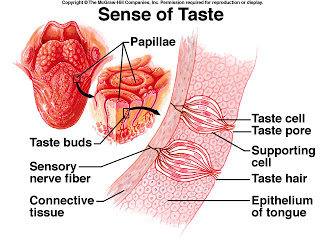You’ve heard people remark that something is an “acquired taste” right? But have you ever thought about what that actually means? What changes in our taste buds that takes us from hating the taste of something to liking the taste?
Taste buds, which are sensory organs, are located in your tongue. If you stick out your tongue you will see that there is vast amount of bumps, these bumps are called papillae. The papillae on your tongue have two responsibilities: they help grip the food you chew and they house the taste buds that allow you to experience if something is sweet, sour, salty, bitter, or umami (we’ll explain). Each taste bud has a microscopic hair, called microvilli, that send signals to your brain about the tastes you are experiencing. All food and drinks are made up of chemicals that give what you are consuming it’s flavor. When you start chewing you are breaking down and releasing these chemicals to be dissolved in your saliva. This is when the hairs pick up the different chemicals and send the message to your brain that then allows you to know if what you’re eating is something that is sour, salty, etc. The process of food turning into taste is called gustation.

There are thousands and thousands of taste buds in your mouth, the average person usually has around 10,000 taste buds that regenerate every 2 weeks. The thing is that taste buds aren’t just in your tongue, you can rest assured that they are also located in the roof of your mouth as well as in your throat. So like stated before your taste buds let you know when something is salty, sweet, sour, bitter, or umami. But what does it mean when something has an umami taste? Well it’s actually just the Japanese word for ‘savory’. Umami literally translates to “pleasant savory taste.” So it’s up to you if you want to act fancy AF and refer to your 5th taste as ‘umami’ or you just want to stick to being basic and refer to it as ‘savory’, we won’t judge.
So what happens when we go from hating a particular food to enjoying it? Well first you have to know that your taste buds don’t work alone to determine taste. Your nose also plays a crucial role in finding something appealing or not. Olfactory receptors inside the nose work with your taste buds when picking up the different chemicals that are released when you chew your food. The olfactory receptors also send the information to your brain so that you know the true flavor of what you are eating. This makes sense when you think about how it is much more difficult to taste your food or drink when you have allergies or a stuffy nose.

The answer to how our preference in taste can change is actually not that scientific. You have the ability to learn to like foods (tastes) you might have previously detested or vice versa. How you respond to a particular taste has to do with many factors: expectation, aversion, exposure, cultural influences, psychological influences, and even age. For instance, if you’ve never been a fan of ginger and you have recently become close with someone who eats it with every meal you might find yourself more inclined to try it which might lead to you developing a taste for it. Or maybe your favorite snack ever since you can remember is potato chips. And one day right before you got stomach poisoning you had eaten a whole bag of your beloved chips, you probably realized after recovering that you can’t even stand the smell of a bowl of chips let alone the taste. This would be called an aversion, an aversion is a distaste you can develop towards something you’ve consumed right before becoming sick, aversions can last anywhere from a couple of weeks to many years. The way you feel about particular tastes will usually be something you have control over so the next time you come across that particular beer you hate the taste of maybe think more positively and give it another chance, after all alcohol is alcohol.










